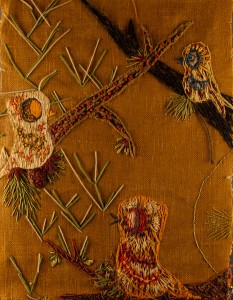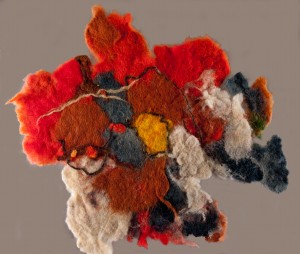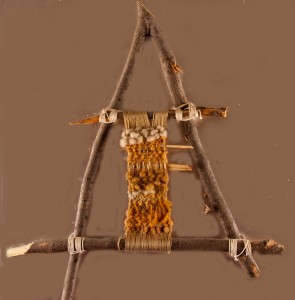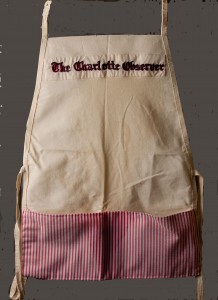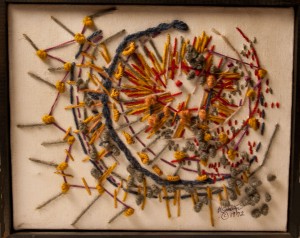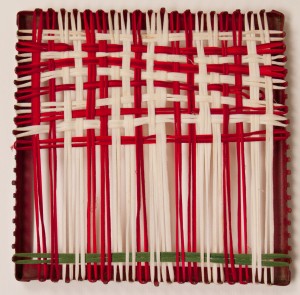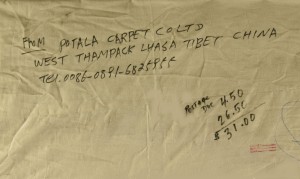 Keep reading to the end – contest notice at the bottom. As my blogs about my Personal Archeology continues (otherwise known as cleaning out the studio), today I’m really showing some of my more embarrassing saves. The detail shot on the left is of a muslin sleeve that was used to ship a small, hand knotted carpet from Tibet. My neighbors were visiting a cottage carpet “factory”, and they bought it for me as a present. There’s quite a story about how the carpet had trouble clearing customs in Los Angeles, and then sat for three months in the local post office before being delivered to my neighbors so they could give it to me. I love the carpet,(and so does one of my cats), but keeping the sleeve? Since it was fabric, I justified keeping it for a number of years, but finally resorted to cutting out a piece of the 48″ (122 cm) tube that had the “from” address. Maybe that will make it into a future project…who knows? It certainly takes up less room.
Keep reading to the end – contest notice at the bottom. As my blogs about my Personal Archeology continues (otherwise known as cleaning out the studio), today I’m really showing some of my more embarrassing saves. The detail shot on the left is of a muslin sleeve that was used to ship a small, hand knotted carpet from Tibet. My neighbors were visiting a cottage carpet “factory”, and they bought it for me as a present. There’s quite a story about how the carpet had trouble clearing customs in Los Angeles, and then sat for three months in the local post office before being delivered to my neighbors so they could give it to me. I love the carpet,(and so does one of my cats), but keeping the sleeve? Since it was fabric, I justified keeping it for a number of years, but finally resorted to cutting out a piece of the 48″ (122 cm) tube that had the “from” address. Maybe that will make it into a future project…who knows? It certainly takes up less room.
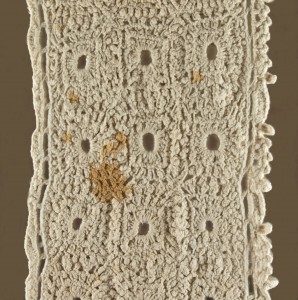 Here’s another find that was being saved for the right re-purposing project that never appeared. It had originally been a table runner for an antique table in my first apartment. Made of cotton butcher’s twine, each of the individual squares measures about 4″ or 10 cm square. Each of the three squares that made up the width of the runner were crudely stitched together with more of the cotton twine using a very large eyed needle. (We were so intense back in those “hippie” days!) After the full length had been created, (about 48″ or 122 cm), then I turned the piece sideways and crocheted an edging the entire length. It took quite awhile to make all of those squares, but given the thickness of the twine, it was hard to get things to sit on top of the runner evenly. Even worse, food/wine stains that weren’t taken care of immediately, got even worse over time, and the big splotch in the center of the above photo was one of the least obtrusive flaws. This piece became relegated to the recycle bin.
Here’s another find that was being saved for the right re-purposing project that never appeared. It had originally been a table runner for an antique table in my first apartment. Made of cotton butcher’s twine, each of the individual squares measures about 4″ or 10 cm square. Each of the three squares that made up the width of the runner were crudely stitched together with more of the cotton twine using a very large eyed needle. (We were so intense back in those “hippie” days!) After the full length had been created, (about 48″ or 122 cm), then I turned the piece sideways and crocheted an edging the entire length. It took quite awhile to make all of those squares, but given the thickness of the twine, it was hard to get things to sit on top of the runner evenly. Even worse, food/wine stains that weren’t taken care of immediately, got even worse over time, and the big splotch in the center of the above photo was one of the least obtrusive flaws. This piece became relegated to the recycle bin.
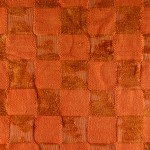 Here’s probably one of my really embarrassing saves. Several years ago, there were a number of products, especially sweaters, that included chenille. They were very soft and comfy, but the trouble was that after a few times in the wash, they loops started to come out. The photo on the left is of an orange bath mat that I loved, but quickly became pretty threadbare.
Here’s probably one of my really embarrassing saves. Several years ago, there were a number of products, especially sweaters, that included chenille. They were very soft and comfy, but the trouble was that after a few times in the wash, they loops started to come out. The photo on the left is of an orange bath mat that I loved, but quickly became pretty threadbare.
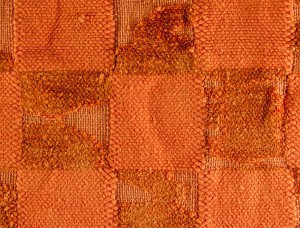 In this closer view, you can see just how empty some of the sections are of their little chenille loops. My big plan was that since there was already an exposed, underlying warp and weft where the loops had been, I could stitch, weave, and bead into those areas and create an orange landscape. One of my favorite books in my collection is KNITTED GARDENS by Jan Messent. I love her use of textures to create very tactile looking landscape surfaces such as little houses, bushes and animals that rise from the a garden surface to make a 3-D garden. I thought that my old bath mat would be a great framework on which to work. That was a “big” plan that never manifested. I began to realize just how heavy that bathmat would be sitting on my lap or on my small portable sewing table to execute the project. Another really important question to ask myself while searching for additional space for what I do want to keep was if I really was ever going to start any project using this bathmat. One of the cats has now claimed it as his nest in my studio, as both cats like to be near me wherever I work. He’s stopped laying on piles of my fabric and he could care less that the piece has holes in it.
In this closer view, you can see just how empty some of the sections are of their little chenille loops. My big plan was that since there was already an exposed, underlying warp and weft where the loops had been, I could stitch, weave, and bead into those areas and create an orange landscape. One of my favorite books in my collection is KNITTED GARDENS by Jan Messent. I love her use of textures to create very tactile looking landscape surfaces such as little houses, bushes and animals that rise from the a garden surface to make a 3-D garden. I thought that my old bath mat would be a great framework on which to work. That was a “big” plan that never manifested. I began to realize just how heavy that bathmat would be sitting on my lap or on my small portable sewing table to execute the project. Another really important question to ask myself while searching for additional space for what I do want to keep was if I really was ever going to start any project using this bathmat. One of the cats has now claimed it as his nest in my studio, as both cats like to be near me wherever I work. He’s stopped laying on piles of my fabric and he could care less that the piece has holes in it.
CONTEST NOTICE
As I was finishing this public confession regarding the “treasures” that I’ve saved over the years, I’ve thought of a great community building project. In the comments section, if you’ll tell us about the most embarrassing thing that you’ve kept for a future piece of artwork but never used, I’ll award prize(s) for the ones that I find the most compelling/unusual/quirky. The contest will run until Oct 31, and the prize(s) will be a small stash of some of my treasures mailed to you for you to include, or not, in your own medium. Since here in the States, Oct. 31st is Halloween, I think this would be a great time to be a little wild and crazy. Want to play???? Tell us about one of your most embarrassing saves for some future art/creativity project and receive a stash of my trash (I mean “treasures”!)
You can see more of my art work on my web site at www.fiberfantasies.com (be patient as it loads; it’s worth it) and can find me on Google + , Facebook, and Twitter.
To find out how to buy my art work, please check out “How to Buy my Art Work” in the “Pages” section to the right of this blog.

